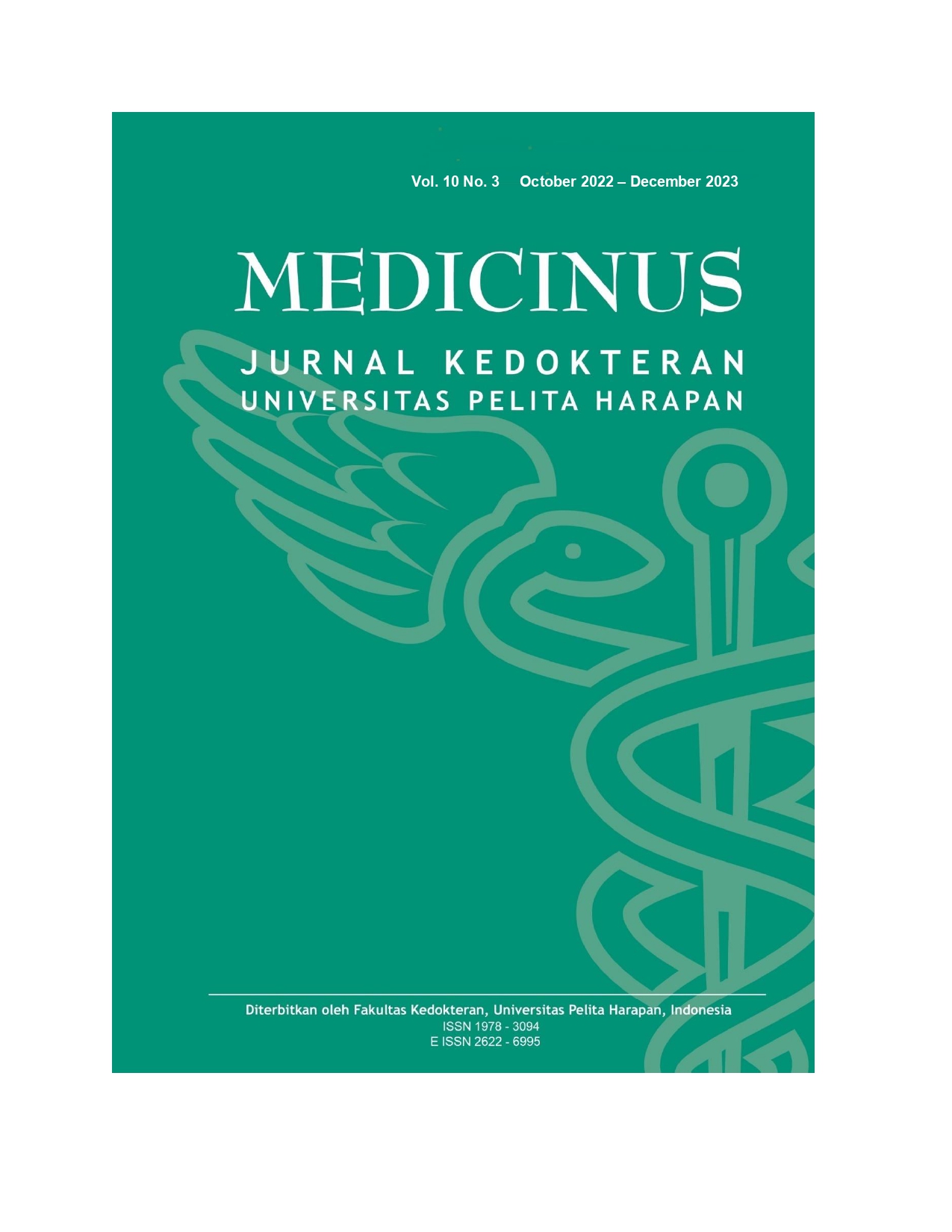Factors Associated With Atopic Dermatitis In Elementary School Children In Suburban Area In Indonesia: Original Research
DOI:
https://doi.org/10.19166/med.v10i3.7034Keywords:
Atopic dermatitis, Associated factors, Atopy, ISAAC, School childrenAbstract
Background: There was limited data of Atopic Dermatitis (AD) prevalence and its associated factors in Indonesia. Therefore, the aim of this study was to identify and evaluate the AD prevalence and factors associated with AD in elementary school children in suburban area in Banten.
Methods: A cross-sectional study was conducted in 3 elementary schools children age 6 - 7 years old who were randomly selected. Information was obtained through an Indonesian version of the International Study of Asthma and Allergies in Childhood questionnaire (ISAAC).
Results: From 304 school children in semi-urban area, AD was reported as ever had an itchy rash which was reccurent for at least 6 months in 17.4% of the children, 19.5% of the children had this itchy rash at any time in the past 12 months, and 11.4 % reported doctor-diagnosed AD. The factors found to be associated with an increased risk of AD were allergic rhinitis (OR 2.151 CI: 1.086-4.261), history of premature birth (<37 weeks) (OR 5.306, CI:1.577-17.858), exclusive breastfeeding (OR 3.126 CI:1.314-7.439), and food allergy (OR 2.912 CI:1.386-6.119).
Conclusion: The results of this study showed that allergic rhinitis, history of premature birth (<37 weeks), exclusive breastfeeding, and food allergy were factors associated with AD in Indonesian schoolchildren.
References
1. Kiken DA, Silverberg NB. Atopic dermatitis in children, part I: epidemiology, clinical features, and complications. Cutis. 2006;78(4):241-7.
2. Barnetson R. Childhood atopic eczema. BMJ. 2002;324(7350):1376-1379. https://doi.org/10.1136/bmj.324.7350.1376
3. Kalmarzi RN, Ataee P, Homagostar G, Tajik M, Ali Shekari, Daem Roshani, Vahid Ghobadi Dana, Sairan Nili. Prevalence of Atopic Dermatitis Symptoms among Students in Kurdistan: a North-west Province of Iran. Int J Pediatr. 2016;4: 1205-1214.
4. The International Study of Asthma and Allergies in Childhood (ISAAC) Steering Committee. Worldwide variation in prevalence of symptoms of asthma, allergic rhinoconjunctivitis, and atopic eczema: ISAAC. Lancet. 1998;351:1225-32.
5. Girolomoni G, Abeni D, Masini C, Sera F, Ayala F, Belloni-Fortina A, et al. The epidemiology of atopic dermatitis in Italian schoolchildren. Allergy. 2003;58(5):420-5. https://doi.org/10.1034/j.1398-9995.2003.00112.x
6. Harris JM, Williams HC, White C, Moffat S, Mills P, Newman AJ, et al. Early allergen exposure and atopic eczema. Br J Dermatol. 2007;156(4):698-704. https://doi.org/10.1111/j.1365-2133.2006.07710.x
7. Arruda LK, Sole D, Baena-Cagnani CE, Naspitz CK. Risk factors for asthma and atopy. Curr Opin Allergy Clin Immunol. 2005;5(2):153-9. https://doi.org/10.1097/01.all.0000162308.89857.6c
8. Peat JK, Allen J, Oddy W, Webb K. Breastfeeding and asthma: appraising the controversy. Pediatr Pulmonol. 2003;35(5):331-4. https://doi.org/10.1002/ppul.10276
9. Beasley R, Clayton T, Crane J, von Mutius E, Lai C, Montefort S et al. Association between paracetamol use in infancy and childhood, and risk of asthma, rhinoconjunctivitis, and eczema in children aged 6-7 years: analysis from Phase Three of the ISAAC programme. The Lancet. 2008;372(9643):1039-1048. https://doi.org/10.1016/s0140-6736(08)61445-2
10. Park YM, Lee SY, Kim WK, Han MY, Kim J, Chae Y, et al. Risk factors of atopic dermatitis in Korean schoolchildren: 2010 international study of asthma and allergies in childhood. Asian Pac J Allergy Immunol. 2015; 34(1):65-72. https://doi.org/10.12932/ap0621.34.1.2016
11. Spergel JM, Paller AS. Atopic dermatitis and the atopic march. J Allergy Clin Immunol. 2003;112(6):S118-S27. https://doi.org/10.1016/j.jaci.2003.09.033
12. Eigenmann PA, Calza AM. Diagnosis of IgE-mediated food allergy among Swiss children with atopic dermatitis. Pediatr Allergy Immunol. 2000; 11(2):95-100. https://doi.org/10.1034/j.1399-3038.2000.00071.x
13. Johansson EK, Bergström A, Kull I, Lind T, Söderhäll C, van Hage M, et al. IgE sensitization in relation to preschool eczema and filaggrin mutation. J Allergy Clin Immunol. 2017; 140(6):1572-1579. https://doi.org/10.1016/j.jaci.2017.04.008
14. Ashley SE, Tan HT, Vuillermin P, Dharmage SC, Tang MLK, Koplin, et al. The skin barrier function gene SPINK5 is associated with challenge-proven IgE-mediated food allergy in infants. Allergy. 2017; 72(9):1356-64. https://doi.org/10.1111/all.13143
15. Kelleher MM, Dunn-Galvin A, Gray C, Murray DM, Kiely M, Kenny L, et al. Skin barrier impairment at birth predicts food allergy at 2 years of age. J Allergy Clin Immunol. 2016; 137(4):1111-6. https://doi.org/10.1016/j.jaci.2015.12.1312
16. Hill DJ, Hosking CS, de Benedictis FM, Oranje AP, Diepgen TL, Bauchau V, et al. Confirmation of the association between high levels of immunoglobulin E food sensitization and eczema in infancy: an international study. Clin Exp Allergy. 2008; 38(1):161-8. https://doi.org/10.1111/j.1365-2222.2007.02861.x
17. Horwitz AA, Hossain J, Yousef E. Correlates of outcome for atopic dermatitis. Ann Allergy Asthma Immunol. 2009; 103(2):146-51. https://doi.org/10.1016/s1081-1206(10)60168-8
18. Eller E, Kjaer HF, Høst A, Andersen KE, Bindslev-Jensen C. Food allergy and food sensitization in early childhood: results from the DARC cohort. Allergy. 2009; 64(7):1023-9. https://doi.org/10.1111/j.1398-9995.2009.01952.x
19. Pónyai G, Hidvégi B, Németh I, Sas A, Temesvári E, Kárpáti S. Contact and aeroallergens in adulthood atopic dermatitis. J Eur Acad Dermatol Venereol. 2008; 22(11):1346-55. https://doi.org/10.1111/j.1468-3083.2008.02886.x
20. Wright AL, Sherrill D, Holberg CJ, Halonen M, Martinez FD. Breastfeeding, maternal IgE, and total serum IgE in childhood. J Allergy Clin Immunol. 1999;104(3Pt1):589-594. https://doi.org/10.1016/s0091-6749(99)70328-3
21. Rudikoff D, Cohen S, Scheinfeld N. Atopic Dermatitis and Eczematous Disorders. Florida: Taylor & Francis Group; 2014. p.87
Downloads
Published
How to Cite
Issue
Section
License
Copyright (c) 2023 Catherine Gunawan, Anthony Satriajaya, Akhil Deepak Vatvani, Kalis Waren, Angela Angela, Resza Broto, Jane Florida Kalumpiu, Sylvia Tan

This work is licensed under a Creative Commons Attribution-ShareAlike 4.0 International License.
Authors who publish with this journal agree to the following terms:
1) Authors retain copyright and grant the journal right of first publication with the work simultaneously licensed under a Creative Commons Attribution License (CC-BY-SA 4.0) that allows others to share the work with an acknowledgement of the work's authorship and initial publication in this journal.
2) Authors are able to enter into separate, additional contractual arrangements for the non-exclusive distribution of the journal's published version of the work (e.g., post it to an institutional repository or publish it in a book), with an acknowledgement of its initial publication in this journal.
3) Authors are permitted and encouraged to post their work online (e.g., in institutional repositories or on their website). The final published PDF should be used and bibliographic details that credit the publication in this journal should be included.





